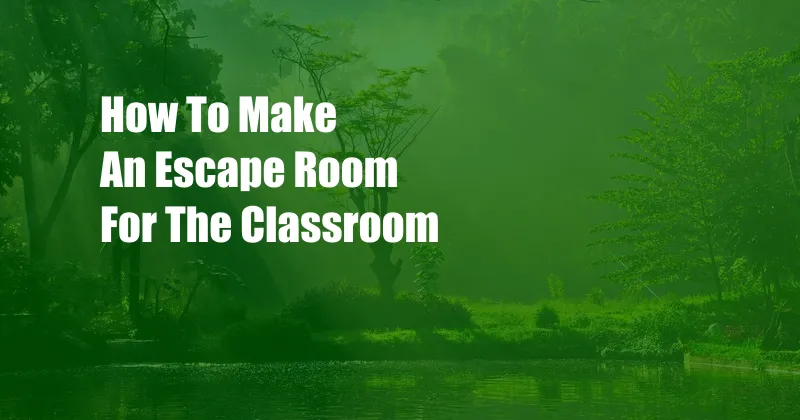
How to Construct a Captivating Escape Room for the Classroom
As a teacher with an unyielding passion for engaging and motivating my students, I was always seeking innovative methods to transform the traditional learning environment into an immersive and interactive experience. It was during a visit to an escape room with my family that an idea sparked within me: why not bring the excitement and problem-solving challenges of an escape room into my classroom?
With enthusiasm and determination, I embarked on a journey to design and implement an escape room experience tailored specifically for my students. The result was an unforgettable learning adventure that fostered collaboration, critical thinking, and a newfound love for the subject matter.
Educational Escape Rooms: A Definition
An educational escape room is an immersive learning environment where students are tasked with solving a series of puzzles and challenges within a predetermined time limit. The puzzles are often designed to align with specific curriculum objectives, promoting collaboration, problem-solving, and critical thinking skills.
Unlike traditional escape rooms, educational escape rooms prioritize learning over adrenaline-pumping thrills. They provide students with a hands-on, engaging experience that encourages them to apply their knowledge and skills in a fun and memorable way.
Creating an Escape Room for the Classroom: A Comprehensive Guide
Crafting an effective escape room for the classroom requires careful planning and preparation. Here are the essential steps involved:
1. Define Your Learning Objectives
Determine the specific learning goals you wish to achieve through the escape room experience. Are you aiming to reinforce a particular concept, develop problem-solving skills, or foster collaboration among students?
2. Design the Puzzles
Create a series of puzzles that are both engaging and relevant to your learning objectives. Consider a mix of puzzles that require different skills, such as problem-solving, code-breaking, and teamwork.
3. Create the Escape Room Environment
Transform your classroom into an immersive escape room experience. Use props, decorations, and sound effects to create an atmosphere that matches the theme of your puzzles.
4. Establish Clear Rules and Instructions
Before beginning the escape room experience, clearly explain the rules and expectations to your students. Establish a time limit and provide guidelines for collaboration and problem-solving.
5. Facilitate and Debrief
Monitor the progress of your students and provide guidance when necessary. After the time limit has expired, lead a debriefing session to reflect on the experience, highlight key learning points, and reinforce the educational objectives.
Tips and Expert Advice for Creating an Unforgettable Escape Room Experience
Based on my own experience and insights from fellow educators, here are some invaluable tips for designing and implementing a successful escape room for the classroom:
1. Incorporate Variety and Balance
Include a diverse range of puzzles that cater to different learning styles and interests. Ensure a balance between puzzles that require logical reasoning and those that involve collaboration.
2. Use Technology Wisely
While technology can enhance the escape room experience, use it sparingly. Focus on puzzles that promote hands-on learning and collaboration rather than relying solely on digital devices.
3. Foster a Positive Learning Environment
Create an atmosphere of respect and encouragement. Encourage students to collaborate and support one another, even if they encounter challenges along the way.
4. Adapt to Different Learning Levels
Design puzzles that cater to students with varying abilities. Provide hints or differentiated support to ensure that all students have the opportunity to participate and succeed.
5. Seek Feedback and Refine
After the escape room experience, gather feedback from your students to identify areas for improvement. Refine your puzzles and learning objectives based on their feedback to enhance the experience for future classes.
Frequently Asked Questions about Educational Escape Rooms
Here are some common questions and answers about educational escape rooms:
Q: How long should an educational escape room last?
A: The optimal length for an educational escape room depends on the age and ability of the students. For younger students, aim for 30-45 minutes, while older students can handle experiences lasting up to an hour.
Q: Can escape rooms be used across different subject areas?
A: Yes, educational escape rooms can be adapted to suit a wide range of subjects, from science and history to language arts and mathematics.
Q: Are escape rooms suitable for all students?
A: While escape rooms can be enjoyable and beneficial for most students, they may not be appropriate for students with certain learning disabilities or behavioral challenges. Consider the individual needs of your students when planning an escape room experience.
Conclusion
Creating an escape room for the classroom is an exciting and rewarding experience that can transform learning into an unforgettable adventure. By following the steps outlined above and incorporating the tips and advice provided, you can design an escape room that engages your students, fosters critical thinking, and reinforces essential learning objectives.
I would love to hear from you! If you have any questions or experiences with educational escape rooms, please feel free to share them in the comments section below. Let’s continue the conversation and inspire each other to create even more immersive and engaging learning experiences for our students.